Related Research Articles

Hermitage Castle is a semi-ruined castle in the border region of Scotland. It stands in the remote valley of the Hermitage Water, part of Liddesdale in Roxburghshire. It is under the care of Historic Scotland. The castle has a reputation, both from its history and its appearance, as one of the most sinister and atmospheric castles in Scotland.

Donnchadh was a Gall-Gaidhil prince and Scottish magnate in what is now south-western Scotland, whose career stretched from the last quarter of the 12th century until his death in 1250. His father, Gille-Brighde of Galloway, and his uncle, Uhtred of Galloway, were the two rival sons of Fergus, Prince or Lord of Galloway. As a result of Gille-Brighde's conflict with Uhtred and the Scottish monarch William the Lion, Donnchadh became a hostage of King Henry II of England. He probably remained in England for almost a decade before returning north on the death of his father. Although denied succession to all the lands of Galloway, he was granted lordship over Carrick in the north.

Liddesdale, the valley of the Liddel Water, in the County of Roxburgh, southern Scotland, extends in a south-westerly direction from the vicinity of Peel Fell to the River Esk, a distance of 21 miles (34 km). The Waverley route of the North British Railway ran down the dale, and the Catrail, or Picts' Dyke, crosses its head.
Geoffrey Wallis Steuart Barrow was an English historian and academic.
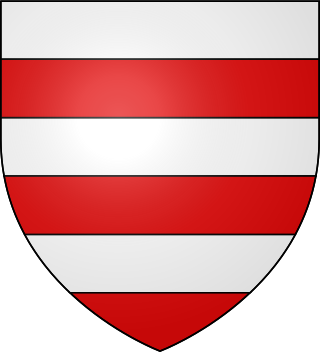
William II de Soules, Lord of Liddesdale and Butler of Scotland, was a Scottish Border noble during the Wars of Scottish Independence. William was the elder son of Nicholas II de Soules, Lord of Liddesdale and Butler of Scotland, and a cousin of Alexander Comyn, Earl of Buchan. He was the nephew of John de Soules, Guardian of Scotland.
Guillaume or William de Malveisin was Chancellor of Scotland, Bishop of Glasgow (1199/1200–1202) and then Bishop of St. Andrews (1202–1238).
Jocelin was a twelfth-century Cistercian monk and cleric who became the fourth Abbot of Melrose before becoming Bishop of Glasgow, Scotland. He was probably born in the 1130s, and in his teenage years became a monk of Melrose Abbey. He rose in the service of Abbot Waltheof, and by the time of the short abbacy of Waltheof's successor Abbot William, Jocelin had become prior. Then in 1170 Jocelin himself became abbot, a position he held for four years. Jocelin was responsible for promoting the cult of the emerging Saint Waltheof, and in this had the support of Enguerrand, Bishop of Glasgow.
Gille Coluim the Marischal was an official of the Scottish crown in the second half of the 12th century. His name occurs in the witness lists of two extant charters, both issued by King William of Scotland at Perth, which indicates that he was probably a native of somewhere in southern Perthshire. He seems in fact to have been the lord of Madderty in Strathearn. In either 1172 or 1173 he witnessed King William's grant of Ardross to Merleswain mac Cholbaín, a relative of the mormaer of Fife.; and somewhere between 1178 and 1185 he witnessed the king's grant of lands in Inverness-shire to Gille Brigte, Mormaer of Strathearn. In both of these charters, the grants are to native Scots and Gille Coluim appears alongside other native Scots, such as Gille Críst mac ingine Samuel and Gille Míchéil mac Donnchada. Gille Coluim in both cases appears with the title "Marescal", meaning that he was the king's military commander. It appears to be in this role that Gille Coluim was given control of the castle at Auldearn ("Heryn") in Moray during a rebellion by the Meic Uilleim, a royal kindred who were claiming the throne of Scotland. A charter issued by King William at Linlithgow, between 1187 and 1189 grants Gille Brigte, mormaer of Strathearn, the land of Madderty and states that neither Gille Coluim nor his heirs have any right to the land after giving up Auldearn to the Meic Uilleim. In the charter, King William declares that Gille Coluim
"feloniously surrendered my castle of Heryn and then went over to my mortal enemies in the manner of a wicked traitor and stood with them against me to do as much harm as he could".
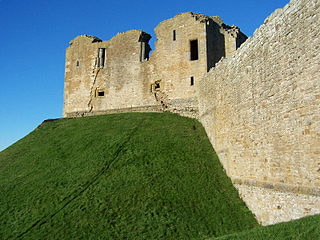
Freskin was a Flemish nobleman who settled in Scotland during the reign of King David I, becoming the progenitor of the Murray and Sutherland families, and possibly others.
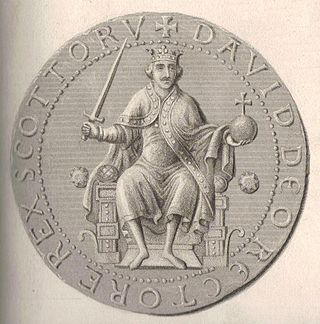
The Davidian Revolution is a name given by many scholars to the changes which took place in the Kingdom of Scotland during the reign of David I (1124–1153). These included his foundation of burghs, implementation of the ideals of Gregorian Reform, foundation of monasteries, Normanisation of the Scottish government, and the introduction of feudalism through immigrant Norman and Anglo-Norman knights.
The first Hugh de Giffard was an influential feudal baron in Scotland, and one of the hostages for the release of King William the Lion in 1174.

The Lord of Liddesdale was a magnate in the medieval Kingdom of Scotland; the territorial lordship of Liddesdale was first created by David I of Scotland, perhaps between 1113 and 1124 when the latter was Prince of the Cumbrians. From an early period the caput of the lordship was Hermitage Castle, the strength of Liddesdale. King David gave the territory to Ranulf de Soules, a knight from the Cotentin Peninsula. It was forfeited by the Soulis family in the 14th century and eventually passed to the Douglases, only to be lost to the Hepburns by order of James IV. Archibald Douglas, 5th Earl of Angus was remunerated for this loss by the lordship of Bothwell Castle, although the Hepburn Earls of Bothwell retained the territorial designation
William II de Haya, was a Norman knight who is considered to be the progenitor of the Scottish Clan Hay. He is the first recorded de Haya in Scotland and is known to have been in the Scottish court in 1160.
Thor of Tranent, also known as Thor, son of Sveinn or Thor, son of Swain, Lord of Tranent and Sheriff of Lothian, was a landlord and chieftain active in Lothian in the reign of King David I of Scotland. He is attested in a large number of charters during King David's reign in Lothian, both as a charter witness on charters granted by other patrons and on charters he himself issued. His name appears either as Thor son of Sveinn or "Thor of Tranent", the latter appellation deriving from his ownership of the "barony" of Tranent, East Lothian, lands including a wide area around the modern town, including, for instance, Prestonpans.

Liddel Castle is a ruined castle in Liddesdale, by the Liddel Water, near Castleton in the Scottish Borders area of Scotland, in the former county of Roxburghshire. Liddel Castle is a scheduled monument.
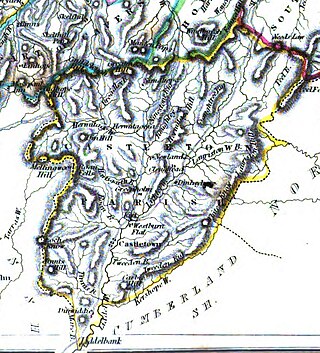
Castleton is a civil parish in the Scottish Borders area of Scotland, in the former Roxburghshire, in the extreme south of the Borders area. It is bounded by Northumberland (England), Dumfries and Galloway, and the parishes of Hobkirk, Southdean and Teviothead. The village of Castleton was commenced in 1793. It was built as a result of the land clearances in the 1790s when people were forced to move from Old Castleton village. While the parish retained the name Castleton, the village later became identified as New Castleton or Newcastleton. The parish is also known by its older name Liddesdale
Philip de Valognes, Lord of Ringwood, Benvie and Panmure was an Anglo-Norman Scottish noble. He was the Lord Chamberlain of Scotland between 1165–1171 and 1193–1214.
Waltheof of Allerdale was an 11th- and 12th-century Anglo-Saxon noble, lord of Allerdale in modern Cumbria. Brother of Dolfin of Carlisle and Gospatric of Dunbar, Waltheof was son of Gospatric, Earl of Northumbria. Both Waltheof and his brother Gospatric witness Earl David's Glasgow Inquest 1113 x 1124, and Waltheof also attests some of David's charters as king of the Scots later. The account of Waltheof and his family in Cumbrian monastic cartularies, says that he gave land in Allerdale to his three sisters, Octreda, Gunhilda and Maud.
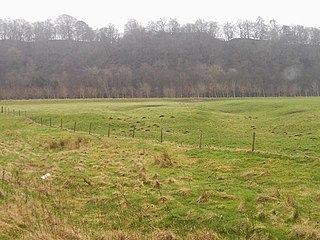
Liddel Strength is an ancient monument near Carwinley, Cumbria, in northwest England. It consists of the earthwork remains of an Anglo-Norman border fortification destroyed by the Scots in 1346 and fragmentary remains of a pele tower subsequently built upon the site. It lies on a cliff on the south bank of the Liddel Water, overlooking the Liddel Water's confluence with the River Esk; the last high ground before the Esk reaches the Solway Plain. The Liddel Water and the Esk (downstream) form the modern Anglo-Scottish border; formerly they were the southern boundary of the Debatable Lands.

Ninestane Rig is a small stone circle in Scotland near the English border. Located in Roxburghshire, near to Hermitage Castle, it was probably made between 2000 BC and 1250 BC, during the Late Neolithic or early Bronze Age. It is a scheduled monument and is part of a group with two other nearby ancient sites, these being Buck Stone standing stone and another standing stone at Greystone Hill. Settlements appear to have developed in the vicinity of these earlier ritual features in late prehistory and probably earlier.
References
- Barrow, G.W.S, editor; Scott, W.W. (1971). Regesta Regum Scottorum Vol II; The Acts of William I, King of Scots, 1165-1214. Edinburgh: Edinburgh University Press.
{{cite book}}:|first1=has generic name (help)CS1 maint: multiple names: authors list (link)
- Barrow, G.W.S.(1973).The Kingdom of the Scots, Government, Church and Society from the eleventh to the fourteenth century,325.New York: St Martin's Press.
- Laurie, A.C. (1905). Early Scottish Charters,Prior to AD 1153. Glasgow: James MacLehose and Sons.
- M' Michael, T. (August 1947). "The Feudal Family of de Soulis". Article 16 Transactions of Dumfreishire and Galloway Natural History and Antiquarian Society. 3rd Series. XXVI.
- Owen, D.D.R. (1997). William the Lion, Kingship and Culture,1143-1214. East Linton, Scotland: Tuckwell Press.
- Robertson, E.W. (1862). Scotland under her Early Kings, Vol.1. Edinburgh: Edmonston and Douglas.
- Robertson, R. (1783). "A Defciption of an Ancient Obelifk, in Berwickshire; With an Engraving". Transactions of Society of Antiquaries of Scotland. I: 268–272.